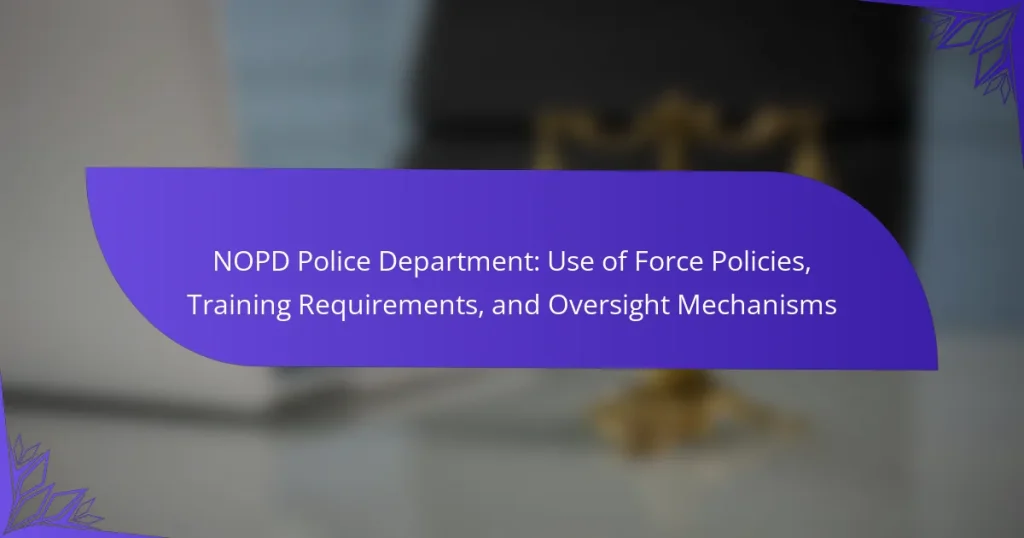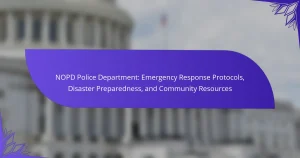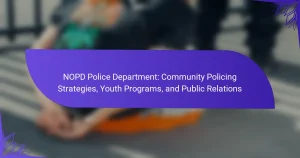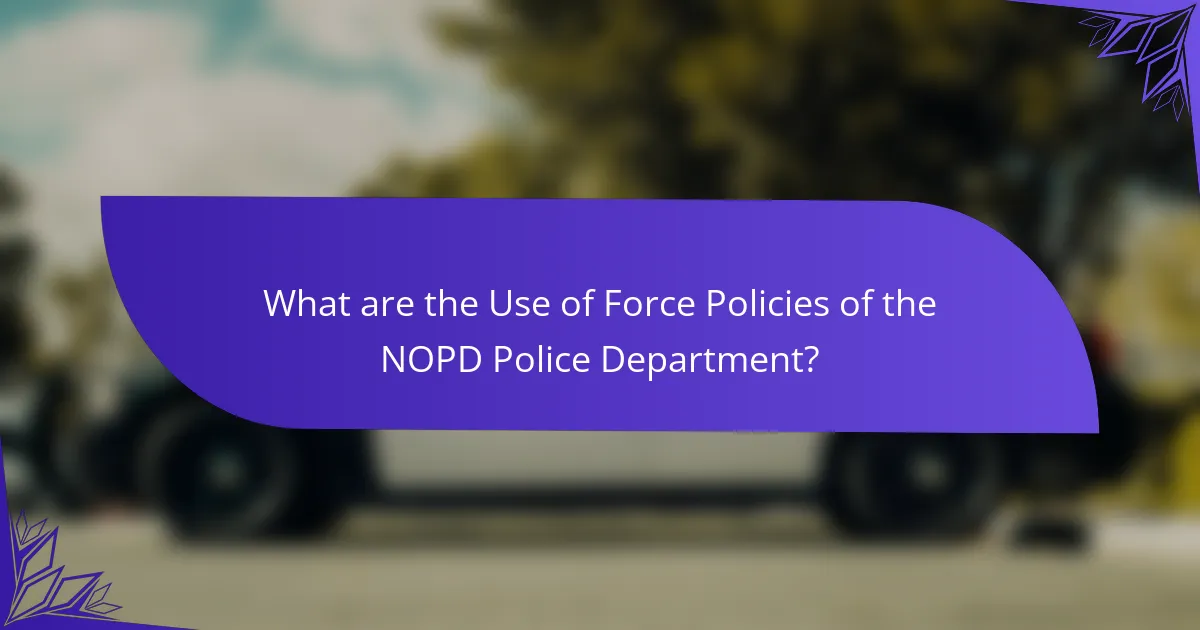
What are the Use of Force Policies of the NOPD Police Department?
The Use of Force Policies of the NOPD Police Department outline the circumstances under which officers may use force. The policies emphasize de-escalation techniques as the preferred response. Officers are trained to assess situations and use the minimum amount of force necessary. The policies also mandate that any use of force must be proportional to the threat faced. Additionally, officers are required to report all incidents involving force. The NOPD policies align with federal standards and guidelines. These policies aim to ensure accountability and transparency in law enforcement practices.
How are the Use of Force Policies defined and implemented?
Use of Force Policies are defined by legal standards and departmental guidelines. They outline acceptable levels of force that law enforcement may use in various situations. Policies are typically developed through collaboration with legal experts, community stakeholders, and law enforcement agencies. Implementation occurs through training programs for officers, ensuring they understand the policies and procedures. Regular reviews and updates to the policies are conducted to reflect changes in laws and community expectations. Compliance is monitored through oversight mechanisms, including audits and reviews of use of force incidents. These measures aim to ensure accountability and transparency in law enforcement practices.
What key principles guide the Use of Force Policies?
Key principles that guide Use of Force Policies include necessity, proportionality, and accountability. Necessity dictates that force should only be used when absolutely required to protect life or prevent serious injury. Proportionality ensures that the level of force used is appropriate to the threat faced. Accountability mandates that officers must be held responsible for their actions when force is applied. These principles are rooted in legal standards and ethical considerations. They are designed to protect both the public and law enforcement officers. Adhering to these principles fosters trust and transparency within the community.
How do these policies align with national standards?
These policies align with national standards by adhering to established guidelines for use of force. The NOPD’s use of force policies reflect the principles outlined by organizations such as the International Association of Chiefs of Police (IACP) and the Police Executive Research Forum (PERF). These organizations advocate for de-escalation techniques and minimal force application. Additionally, the policies incorporate training requirements that meet or exceed national benchmarks. For instance, the NOPD mandates ongoing education in crisis intervention and mental health awareness. This ensures officers are equipped to handle various situations appropriately. Furthermore, oversight mechanisms are in place to review incidents and ensure accountability, aligning with best practices in law enforcement.
What types of force are addressed in the NOPD’s policies?
The NOPD’s policies address several types of force. These include lethal force, non-lethal force, and physical force. Lethal force is defined as actions that can result in death. Non-lethal force encompasses methods that do not intend to cause serious injury or death. Physical force refers to any use of physical strength to control a situation. The policies outline specific guidelines for each type of force. These guidelines are intended to ensure proper use and accountability.
What are the different levels of force recognized by the NOPD?
The New Orleans Police Department (NOPD) recognizes several levels of force. These levels include physical presence, verbal commands, soft hands, hard hands, and lethal force. Physical presence involves officers being present to deter criminal activity. Verbal commands are used to instruct individuals on compliance. Soft hands refer to non-aggressive techniques for controlling a subject. Hard hands involve more aggressive tactics to gain control. Lethal force is used only in life-threatening situations. These classifications guide officers in appropriate responses during encounters.
How does the NOPD categorize non-lethal and lethal force?
The NOPD categorizes force into two primary types: lethal and non-lethal. Lethal force is defined as force that can cause death or serious bodily injury. Non-lethal force encompasses methods that are intended to incapacitate or control a subject without causing permanent harm. The NOPD outlines specific circumstances under which each type of force may be used. Lethal force is typically reserved for situations where an officer’s life or the life of others is in imminent danger. Non-lethal force includes tactics such as verbal commands, physical restraint, and use of less-than-lethal weapons. The categorization is part of the NOPD’s use of force policy aimed at ensuring the appropriate application of force in various scenarios.
What role does training play in the NOPD’s Use of Force Policies?
Training is essential in the NOPD’s Use of Force Policies. It ensures officers understand the appropriate use of force in various scenarios. Regular training sessions focus on de-escalation techniques and proper decision-making. This training aims to minimize unnecessary force and enhance public safety. The NOPD mandates ongoing education to keep officers updated on policies. Statistics show that departments with comprehensive training see fewer incidents of excessive force. Training also reinforces accountability and adherence to legal standards. Overall, effective training is crucial for responsible policing within the NOPD.
What are the training requirements for NOPD officers regarding use of force?
NOPD officers must complete training on use of force as part of their police academy curriculum. This training includes understanding the legal standards for use of force, de-escalation techniques, and the department’s specific policies. Officers receive instruction on the appropriate levels of force based on various scenarios. The training emphasizes the importance of using minimal force necessary to control a situation. Additionally, officers participate in scenario-based exercises to practice their skills. Regular refresher courses are mandated to ensure ongoing compliance with updated policies. The training requirements are designed to promote accountability and community trust.
How often are officers required to undergo use of force training?
Officers are typically required to undergo use of force training annually. This training is essential for maintaining proficiency in handling various situations. The frequency ensures that officers stay updated on policies and best practices. Regular training helps to reinforce the principles of de-escalation and appropriate use of force. Additionally, it aligns with national standards for law enforcement training. The annual requirement reflects a commitment to accountability and community safety.
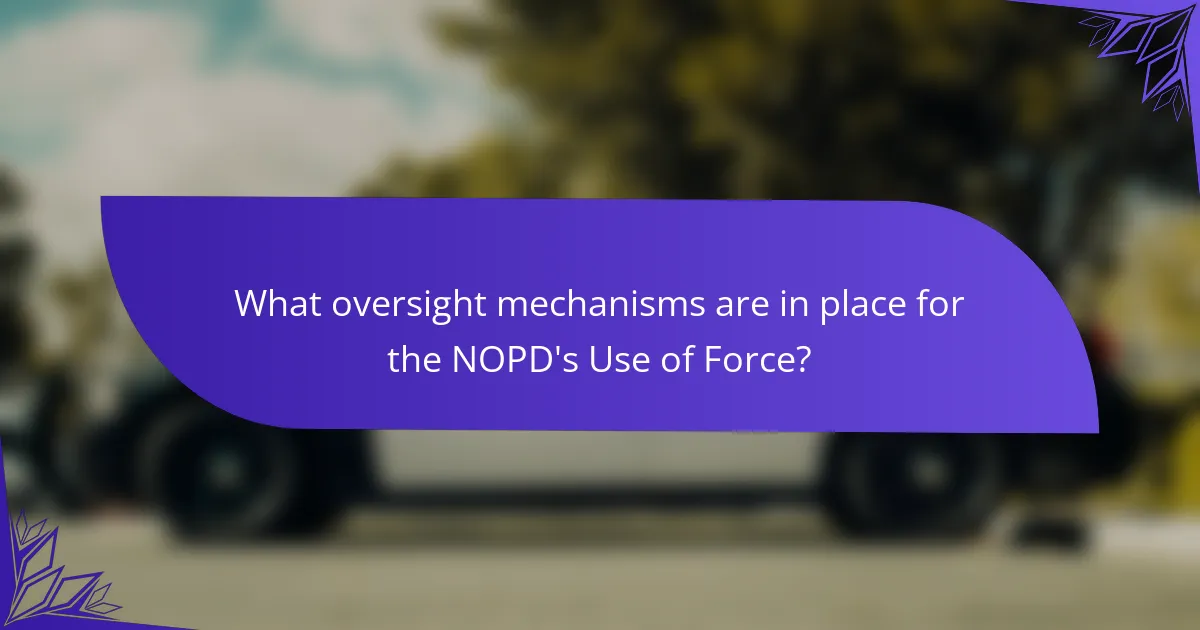
What oversight mechanisms are in place for the NOPD’s Use of Force?
The New Orleans Police Department (NOPD) has several oversight mechanisms for its Use of Force policies. These include the Office of the Independent Police Monitor (OIPM), which reviews complaints and incidents involving force. The OIPM provides public reports and recommendations for policy improvements. Additionally, the NOPD has an Internal Affairs Division that investigates allegations of misconduct related to Use of Force. The department also engages in regular training and reviews of Use of Force incidents to ensure compliance with established policies. Furthermore, community oversight boards contribute to the evaluation of police practices and accountability. These mechanisms are designed to enhance transparency and accountability within the NOPD’s operations.
How does the NOPD ensure accountability in the use of force?
The NOPD ensures accountability in the use of force through comprehensive policies and oversight mechanisms. These policies include strict guidelines on when and how force can be applied. Officers are required to report all use of force incidents. Each incident undergoes a thorough review process. This review may involve internal investigations and external oversight bodies. The NOPD also provides regular training on de-escalation techniques. Data on use of force incidents is collected and analyzed for trends. Transparency is maintained by publicly reporting use of force statistics. These measures collectively enhance accountability and public trust in the NOPD.
What internal review processes are implemented for use of force incidents?
Internal review processes for use of force incidents include comprehensive investigations and assessments. The NOPD conducts a thorough examination of each incident involving force. This process often involves reviewing body camera footage, witness statements, and police reports. Additionally, a designated internal review board evaluates the findings. This board assesses compliance with departmental policies and applicable laws. The outcomes of these reviews can lead to disciplinary actions or policy changes. These processes ensure accountability and transparency within the department. Regular audits of these reviews help maintain oversight and improve practices over time.
How does community feedback influence oversight mechanisms?
Community feedback significantly shapes oversight mechanisms by providing essential insights into public perceptions and concerns. This feedback can highlight areas where oversight may be lacking or ineffective. For instance, community input can lead to the establishment of new oversight bodies or the reform of existing ones. Surveys and public forums often reveal specific incidents or trends that require attention. Additionally, feedback helps ensure that oversight mechanisms remain accountable to the community they serve. When communities feel heard, they are more likely to engage with oversight processes. Research shows that departments that incorporate community feedback tend to have improved trust and cooperation. This ultimately enhances the effectiveness of oversight mechanisms in promoting accountability and transparency.
What external oversight bodies monitor the NOPD’s use of force?
The external oversight bodies that monitor the NOPD’s use of force include the New Orleans Independent Police Monitor and the New Orleans Civilian Review Board. The New Orleans Independent Police Monitor is responsible for overseeing police practices and ensuring accountability. The Civilian Review Board reviews complaints against police officers and makes recommendations. These bodies aim to promote transparency and community trust in law enforcement. They also provide recommendations for policy changes based on their findings. Their roles are crucial in maintaining checks and balances within the police department.
What is the role of civilian review boards in overseeing police actions?
Civilian review boards are independent bodies that oversee police actions. Their primary role is to investigate complaints against police officers. They provide an avenue for community members to voice concerns about police conduct. Civilian review boards aim to ensure accountability and transparency within law enforcement agencies. They often review policies and procedures to recommend improvements. Many boards have the authority to make disciplinary recommendations. Their findings can influence public trust in the police. Research indicates that civilian oversight can lead to a decrease in police misconduct.
How do state and federal agencies contribute to oversight?
State and federal agencies contribute to oversight by establishing regulations and standards for law enforcement practices. They provide funding and resources to support compliance with these standards. Agencies like the Department of Justice conduct investigations into police conduct. They also offer technical assistance and training to improve agency operations. Federal oversight can include monitoring through consent decrees, which enforce reforms. State agencies may conduct audits and reviews of local police departments. This collaboration ensures accountability and transparency in law enforcement. Overall, these efforts aim to enhance public trust and community relations.

What are the implications of the NOPD’s Use of Force Policies?
The implications of the NOPD’s Use of Force Policies include accountability, public safety, and community relations. These policies establish guidelines for officers on when and how to use force. They aim to minimize excessive force incidents, thereby promoting accountability within the department. Improved training requirements are part of these policies, ensuring officers are better prepared to handle various situations. This can lead to a reduction in complaints against officers and enhance public trust. Research indicates that clear use of force policies can decrease incidents of violence between police and community members. The U.S. Department of Justice has emphasized the importance of such policies in fostering positive police-community interactions.
How do these policies affect community relations?
These policies significantly impact community relations by fostering trust and accountability. Effective use of force policies ensure that officers are trained to de-escalate situations. This training reduces the likelihood of violent encounters between police and community members. Additionally, oversight mechanisms provide transparency in police actions. Communities are more likely to support law enforcement when they see accountability for misconduct. Research indicates that departments with strong oversight report better relationships with the community. For example, a study by the Police Executive Research Forum found that transparency improves community perceptions of police legitimacy.
What are the public perceptions of the NOPD’s use of force?
Public perceptions of the NOPD’s use of force vary significantly. Many community members express concerns about excessive force and racial bias. Surveys indicate that a substantial portion of the public feels distrust toward the NOPD regarding its handling of use-of-force incidents. Reports of high-profile cases have fueled skepticism about accountability. Data from the U.S. Department of Justice highlights ongoing issues related to community relations. Local activists frequently voice demands for reform and transparency. Overall, perceptions reflect a complex relationship between the NOPD and the communities it serves.
How do use of force incidents impact trust in law enforcement?
Use of force incidents significantly diminish trust in law enforcement. When officers engage in excessive force, community perceptions of safety and legitimacy are adversely affected. Studies show that communities exposed to high-profile use of force cases experience increased distrust. For instance, a 2016 study by the Pew Research Center found that 72% of Black Americans reported a lack of confidence in police. This erosion of trust can lead to reduced cooperation with law enforcement. Additionally, negative media coverage amplifies public scrutiny and skepticism. Trust is crucial for effective policing, as it fosters community engagement and compliance. Therefore, managing use of force incidents is essential for maintaining public confidence in law enforcement agencies.
What best practices can enhance the NOPD’s Use of Force Policies?
Implementing de-escalation training can enhance the NOPD’s Use of Force Policies. This training equips officers with skills to resolve conflicts without resorting to force. Studies show that departments with de-escalation training report fewer use of force incidents. Regular review and revision of policies ensure they reflect current best practices and legal standards. Transparency in reporting use of force incidents builds community trust. Engaging community stakeholders in policy development fosters accountability. Data collection and analysis on use of force incidents help identify patterns and inform training needs. Establishing clear guidelines for when force is appropriate can reduce ambiguity for officers.
How can training programs be improved for better outcomes?
Training programs can be improved by incorporating evidence-based practices and regular assessments. Implementing scenario-based training enhances decision-making skills. Continuous feedback from participants can identify areas for improvement. Additionally, integrating community input fosters trust and relevance in training. Studies show that programs with diverse training methods yield better retention rates. Research indicates that ongoing training leads to improved performance in real-world situations. Regular updates to training materials based on recent data ensure relevance. Finally, evaluating training outcomes through metrics can guide future enhancements.
What strategies can be employed to foster community engagement?
Community engagement can be fostered through transparent communication and active collaboration. Establishing regular community meetings allows residents to voice concerns. Implementing feedback mechanisms encourages community input on police practices. Utilizing social media platforms enhances outreach and information sharing. Partnering with local organizations strengthens community ties and resources. Conducting educational workshops promotes understanding of police policies. Developing community policing initiatives fosters trust and cooperation. Providing opportunities for volunteer involvement increases community investment in public safety.
The main entity of this article is the New Orleans Police Department (NOPD) and its Use of Force Policies. The article provides a detailed overview of the NOPD’s guidelines for the application of force, emphasizing the importance of de-escalation techniques, proportionality, and accountability. It outlines the training requirements for officers, the various types of force recognized, and the oversight mechanisms in place to ensure compliance and transparency. Additionally, the article discusses the implications of these policies on community relations and trust in law enforcement, as well as best practices for enhancing the effectiveness of the NOPD’s use of force strategies.
